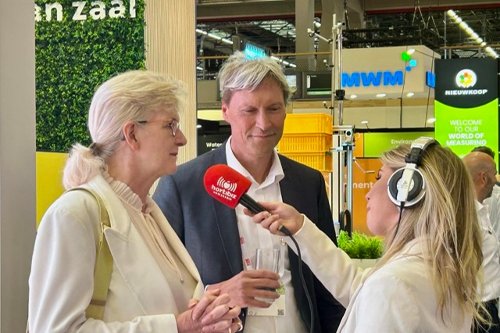Harnessing light's power for cut flower production
Added on 22 June 2023

This business case will expound on the results of dynamic LED lighting in propagation and cut flower production. It will highlight its impact on various plant characteristics and the proven effectiveness of Sollum’s 100% programmable LED grow light solution in greenhouses.
Propagation: enhancing transplant characteristic and growth control.
Propagation greenhouses face the challenge of growing a variety of crops in quick succession, including cucumbers, tomatoes, peppers, and eggplants. The most important characteristics of transplants are height and stem thickness, which significantly influence their quality.
Light intensity and spectrum play a vital role in shaping these characteristics. By increasing the percentage of blue light, growers can effectively restrict stretching and slow plant growth, leading to compact and sturdy transplants. This feature proves particularly useful when there is a need to delay shipping or planting, allowing growers to maintain flexibility in their operations.
Furthermore, results have shown that blue light thickens stems and leaves, providing additional strength and structural integrity to the plants. These attributes are especially beneficial for crops that require robust support, such as vine crops. High red and far-red light levels can drive photosynthesis through the Emerson effect, ensuring an adequate energy supply for the growth and development of slower-growing plants like peppers and eggplants. By harnessing the power of dynamic LED lighting, greenhouse growers can keep the production of these crops on track, achieving optimal yields and maintaining consistent quality.

Sollum’s LED grow light solution has proven its efficacy in producing various transplants, including tomatoes, peppers, eggplants, strawberries, and cucumbers. Growers who have adopted the Sollum solution have reported strong rooting, minimal leaf curl or stress, and appropriate plant height, indicating the positive impact of dynamic LED lighting on transplants’ overall health and vigor.
Cut flower production: precision spectrum for captivating coloration.
Cut flower greenhouses often accommodate multiple flower types and varieties, each with unique lighting requirements. The lighting recipe applied to a particular flower type can significantly influence its growth, development, and aesthetic appeal.
For example, the lighting needs of a white rose may differ from those of darker-colored varieties. When exposed to temperature stress, pale roses tend to exhibit stress-induced color changes, developing a pinkish hue. Therefore, the environmental strategy, including light, must be carefully managed to favour deep coloration in dark cultivars and promote pale coloration in lighter cultivars.
Different flower types have specific photoperiod and spectrum requirements. For instance, gerbera flowers thrive under an 11–12-hour photoperiod, whereas roses require a more extended photoperiod of 17-18 hours to ensure proper extension and flowering. Spectrum-wise, roses generally benefit from a higher percentage of red light (around 50-60%), as it promotes their growth, flowering, and vibrant coloration. On the other hand, studies have shown that alstroemeria, a popular cut flower, produces the highest number of flowers, longest flowers, and highest fresh weight under equal amounts of blue, green, red, and far-red light, indicating the importance of providing a more balanced spectrum for optimal alstroemeria production.
Additionally, far-red light plays a crucial role in triggering flowering in long-day plants. By utilizing dynamic LED lighting with appropriate far-red wavelengths, greenhouse growers can effectively regulate flowering and maintain a consistent production schedule. This aspect is vital for growers working with seasonal markets, enabling them to meet the demand for cut flowers during specific periods.
Spectrum-wise, Sollum’s dynamic LED grow light solution has also demonstrated remarkable results in the production of ornamental bedding plants. Its adaptability allows growers to cultivate a multitude of species and varieties of bedding plants in the same greenhouse while having a marked effect on the coloration of uniquely pigmented ornamental plants like Dusty Miller and Coleus. By fine-tuning the spectrum, growers can achieve stunning color variations and enhance the visual appeal of their bedding plants.
Dynamic LED lighting provides critical factors for propagation and cut flower production.
Enhanced crop control: growers can precisely control plant growth and development by manipulating light intensity and spectrum. Increased blue light restricts stretching and produces compact transplants, while high red and far-red levels drive photosynthesis for slower-growing crops.
Improved plant quality: dynamic LED lighting strengthens stems and leaves, producing more robust, healthier plants. This feature is particularly advantageous for vine crops that require substantial support.
Flexibility and adaptability: with dynamic LED lighting solutions like Sollum, growers can easily adjust the lighting recipe to meet the specific requirements of different crops and varieties. This adaptability ensures optimal growth conditions and maximizes crop performance.
Consistent production schedule: by providing the appropriate photoperiod and spectrum, dynamic LED lighting helps manage flowering in daylength-sensitive crops, with additional far-red promoting flowering in long-day crops and restricting flowering in short-day crops. This allows growers to maintain a reliable production schedule crucial for meeting seasonal market demands.
Enhanced aesthetic appeal: optimization of the light spectrum directly impacts the coloration of cut flowers. By utilizing dynamic LED lighting, growers can achieve deep, vibrant colors in dark cultivars and delicate, pale hues in lighter cultivars, enhancing the overall visual appeal of their cut flower products.

In conclusion, dynamic LED lights, such as Sollum’s solution, offer significant advantages for both produce propagation and cut flower production. By harnessing the power of light intensity and spectral control, growers can optimize plant growth, enhance plant quality, and meet the specific requirements of different crops and varieties.
Real-world results show growers can achieve their intended outcome in various transplants, including tomatoes, peppers, eggplants, strawberries, and cucumbers. Dynamic LED facilitates strong rooting, minimal leaf curl or stress, and desired plant height.
The ability to easily manipulate light allows precise control over height, stem thickness, and flowering, ensuring consistent production and attractive coloration in cut flowers. Incorporating dynamic LED lighting into propagation and cut flower greenhouses gives growers a powerful tool to maximize crop performance, increase yields, and meet market demands.
Want to learn more about Sollum Technologies and its dynamic LED grow light solution? CLICK HERE.
More news















